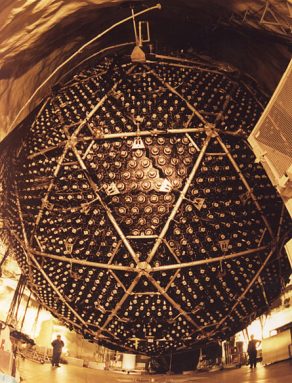Earth from the inside out
An invisible particle sheds light on the mysterious interior of the Earth
 |
|
Originally used to detect elusive particles from space called neutrinos, the four-story detector at the Sudbury Neutrino Observatory could be retrofitted to detect antinutrinos produced by natural radioactivity inside Earth.
|
| Courtesy of Lawrence Berkeley National Laboratory |
Scientists have long known this strange fact: It’s easier to look deep into space than into the center of Earth. Light can pass through most of space, so the light from distant stars can easily be seen with the naked eye. But Earth is opaque, which means that light cannot pass through it.
If light cannot pass through it, then we cannot see what’s on the inside of our planet. So if we can’t use light to see inside our own planet, what can we use?
Recently, some scientists have been trying to use neutrinos — tiny particles smaller than an atom that zip through space. Neutrinos come from the sun or other distant stars, and astronomers have studied them for years. Now, a team of geoscientists — “geo” means Earth — think a kind of neutrino may have something to say about the Earth, too.
Not all neutrinos come from outer space. Special neutrinos called geoneutrinos are generated from within the Earth. (Remember that “geo” means Earth.) Most of these local neutrinos come from either the crust or the mantle. The crust is Earth’s outermost shell, what we stand on, and the mantle is five to 25 miles below the crust. Certain elements within the Earth can send off geoneutrinos when undergoing a process called radioactive decay.
During radioactive decay, a material loses some of its energy by sending out particles and radiation. An element that goes through this process is said to be radioactive, and radioactive elements occur naturally in the Earth. Some radioactive elements produce geoneutrinos.
After they are produced, geoneutrinos pass straight through the solid Earth without being absorbed or bouncing around. If they’re not stopped, they go straight into outer space — and keep going, and going and going. Geoscientists hope to catch a few of these particles on their way out, but it’s not going to be easy.
There are two big problems: There aren’t that many geoneutrinos, and they’re hard to find. To catch these elusive particles, scientists have designed special geoneutrino detectors. These strange-looking scientific instruments are giant, metal spheres buried deep underground.
In an abandoned mine in Canada, for example, scientists are preparing a geoneutrino detector that is four stories tall and more than a mile underground. The detector will be filled with a special liquid that flashes when a geoneutrino passes through. The liquid “produces a lot of light, and it’s very transparent,” says Mark Chen, the director of the project. When it’s up and running, probably in 2010, the detector will find only about 50 geoneutrinos per year. Other detectors are being planned all over Earth — one of them is even supposed to sit on the bottom of the ocean!
The geoscientists who study geoneutrinos hope that the particles will help answer an old question about the Earth. The interior of the Earth is blistering hot, but where does the heat come from? They know that part of the heat — maybe as much as 60 percent — comes from radioactive decay, but researchers want to know for sure. By measuring geoneutrinos, scientists hope to figure out how radioactive decay helps heat Earth.
Going Deeper:







